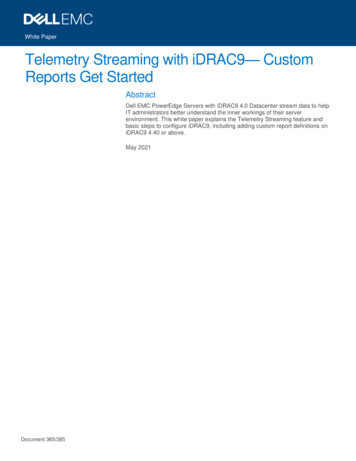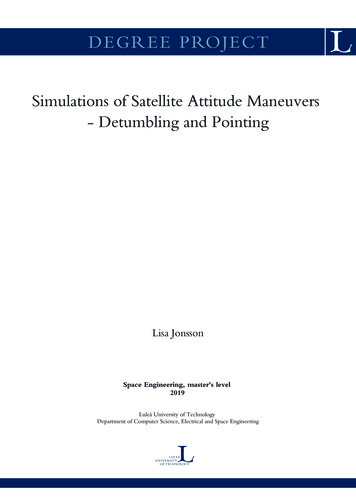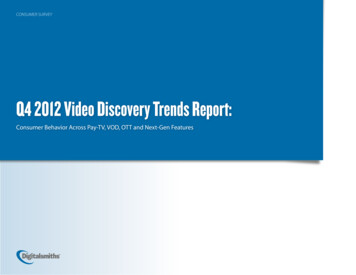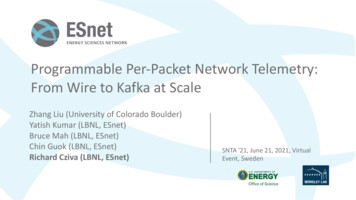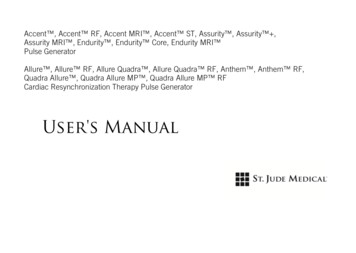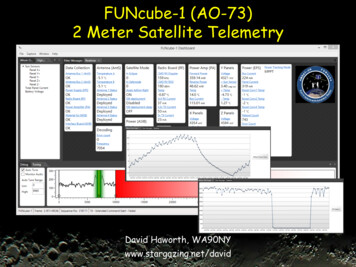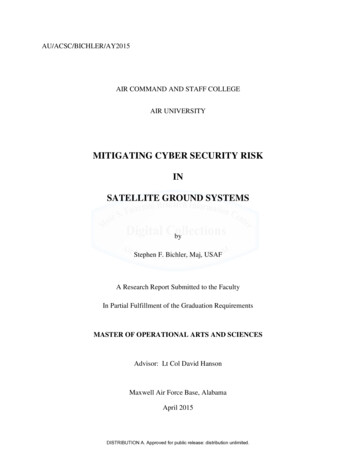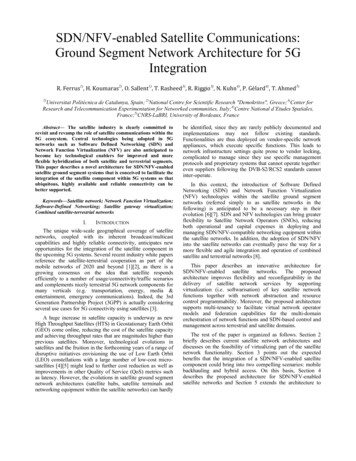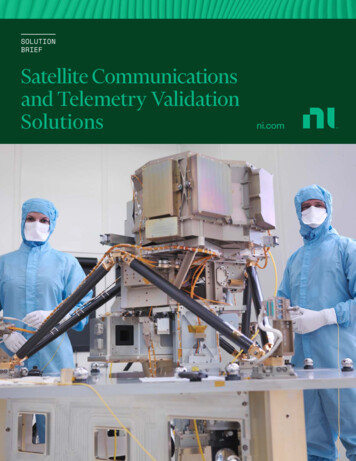
Transcription
SOLUTIONBRIEFSatellite Communicationsand Telemetry ValidationSolutionsni.com
SATELLITE COMMUNICATIONS AND TELEMETRY VALIDATION SOLUTIONSExplore NI’s SolutionsThe recent commercialization of low Earth orbit (LEO) andmedium Earth orbit (MEO) has led to an introduction of modernsatellite-based applications like non-terrestrial networks (NTN)and high-resolution remote sensing and imagery. The satelliteconstellations, ground equipment, and supporting launchvehicles developed to support these new services comewith new communication and data link technologies that, inturn, include new challenge in design, system validation, andproduction test.NI offers a broad range of hardware and software validationsolutions to assist you in developing high-performance spacecommunication systems.IMPORTANCE OF03 SYSTEMS TESTSATCOM AND TELEMETRYNI SOLUTIONS FOR SATCOM04 TELEMETRY VALIDATIONSATCOM AND TELEMETRY05 AND SOFTWAREANDVALIDATION HARDWARE
Importance of SATCOM andTelemetry Systems TestThe small-satellite constellations being deployed to facilitate newapplications can range from one to several thousand in size, eachrapidly orbiting the earth. This dynamic nature presents a challenge forcommunications and connectivity for both inter-satellite and ground stationdata links. In response, cutting-edge communication systems have beendeveloped using modern electronically scanned array (ESA) antennas thatcan rapidly shift one or more beams without any mechanical movement. Thisallows for the telemetry, tracking, and control (TT&C) of multiple satellitesat once while in the field of view of the array. More importantly, these ESAarrays are inherently modular and scalable allowing for ground terminalsand payloads to be optimized for specific applications and missions. Thesedata links are further supported via software defined radio (SDR) backends.These SDR implementations allow for adaptive and reconfigurable data linkssuch as the Consultative Committee for Space Data Systems (CCSDS).Customer Needs01Dynamic satellite constellations02Telemetry, tracking, and control ofmultiple satellites at once03Proliferation of software-defined radiosInter-Satellite Data LinkPlayload Data Linkand CommunicationsTelemetry, Tracking,and Control SubsystemSoftware DefinedRadio (SDR)Ground StationFIGURE 01Critical Communications Systems for Spacecraft OperationsSATELLITE COMMUNICATIONS AND TELEMETRY VALIDATION SOLUTIONS03
NI Solutions for SATCOM andTelemetry ValidationThe NI solution for SATCOM and Telemetry systems validation consists ofCOTS modular hardware and flexible software tools to address RF signalfidelity, system level validation, and digital system test requirements. Thesolution is built on the PXIe modular test platform that can be customizedto meet your specific IO performance requirements.The NI Vector Signal Transceiver (VST) is the central RF technology forthis solution. On its own, the VST can transmit and receive TT&C andSATCOM data link signals performing key signal fidelity measurementssuch as modulation accuracy, transmit power, and more. The VST canbe augmented with a PXIe FlexRIO coprocessor with full-rate streamingto and from an open FPGA capable of hosting real-time, inline signalprocessing and channel models. With a coprocessor configuration, the VSTis transformed into an RF channel emulator—unlocking the ability to do fullsystem level validation.PXIe SystemPlatformJ3U ModularInstrumentation ChassisJExpandable to 18 slotsJData Transfer up to 24 GB/sJIntegrated Clocking/TriggersDigital system test is accomplished with the use of NI FlexRIO modulesas well, yet with a digital front-end configuration. NI FlexRIO combines alarge user-programmable FPGA with a serial or parallel digital IO to meetthe system interfacing and IP protocol requirements of satellite payloadsubsystems test. With NI FlexRIO, engineers can import custom digitalprotocols to emulated digital interfaces without using custom hardware.VSTFPGACoprocessorHigh-Speed DigitalData and ControlDOPPLER SHIFTCHANNEL DELAYTT&C SignalsSPACE VEHICLERF and Digital Link Parametric TestVSTFPGACoprocessorSatcom Data LinkGROUND STATIONCHANNELIMPAIRMENTSChannel EmulationFIGURE 02Common SATCOM and Telemetry TestsSATELLITE COMMUNICATIONS AND TELEMETRY VALIDATION SOLUTIONS04
SATCOM and TelemetryValidation Hardware and SoftwareVECTOR SIGNAL TRANSCEIVERThe PXI Vector Signal Transceiver (VST) combines a vector signal analyzer andvector signal generator with a user-programmable FPGA and high-speed serial andparallel digital interfaces for real-time signal processing and control. With up to 1 GHzof instantaneous RF bandwidth, and frequency coverage from 9 KHz to 44 GHz, it’sfully capable of covering all the key SATCOM frequency bands (L, S, C, X, Ku, and Ka).The NI VST is ideally suited for modulated signal generation and spectral analysis. TheVST product line provides the high-performance measurements and the fast speedfor automation in a small form factor. You can use VST instruments throughout thedesign cycle from design to validation to production test—minimizing measurementcorrelation errors and improving efficiency with test software reuse. The modular PXIplatform allows users to configure systems with multiple VSTs to support multipleinput, multiple output (MIMO) applications, and simplifies synchronization betweeninstruments thanks to shared timing and synchronization resources in the PXI chassis.HIGH-SPEED SERIAL INSTRUMENTSPXI High-Speed Serial Instruments are designed for engineers who need to validate,interface through, and test high-speed serial protocols. They consist of Xilinx Kintex-7,Virtex-7, and UltraScale FPGAs and are programmable in LabVIEW FPGA formaximum application-specific customization and reuse. These instruments takeadvantage of FPGA multigigabit transceivers (MGTs) to support line rates up to 28 Gbpsand up to 24 TX and RX lanes. As part of the PXI platform, they benefit from PXI clocking,triggering, and high-speed data movement capabilities, including streaming to andfrom disk, as well as peer-to-peer (P2P) streaming at rates up to 3.2 GB/s.PXI FLEXRIO COPROCESSOR MODULESPXI FlexRIO Coprocessor Modules feature high-performance FPGAs that add signalprocessing capability to PXI systems. These modules leverage the latest FPGAs fromXilinx, streaming technologies such as PCI Express, and NI Peer-to-Peer Streamingfor high-bandwidth data communication with other modules over the backplane.When paired with another PXI device, such as a PXI Vector Signal Transceiver, PXIFlexRIO Coprocessor Modules provide the additional FPGA resources required torun complex algorithms in real time. Import your VHDL or Verilog channel modelalgorithms easily with LabVIEW FPGA Component Level IP Integration capabilities.SATELLITE COMMUNICATIONS AND TELEMETRY VALIDATION SOLUTIONS05
LABVIEW FPGALabVIEW FPGA is a software add-on for LabVIEW that you can use to more efficiently and effectively design FPGA-based systems througha highly integrated development environment, IP libraries, a high-fidelity simulator, and debugging features. You can create FPGA VIsthat combine direct access to I/O with user-defined LabVIEW logic to define custom hardware for applications such as digital protocolcommunication, hardware-in-the-loop simulation, and rapid control prototyping. Though the LabVIEW FPGA Module contains many built-insignal processing routines, you can also integrate existing hardware description language (HDL) code as well as third-party IP.Program with LabVIEW FPGALabVIEW Programming elementsDevelop, simulate, debug, compile, and deploythrough LabVIEWIntegrate external FPGA IPHigher-level language to abstract throusandsof VHDL code linesJJHigh-Performance FeaturesHigh-throughput math functionsAdvanced timing controlAccess to optimized DSP coresJJJJJAccess to IO and PeripheralsSimple API for front-panel IOHigh-bandwith streaming over PCI Express to Host or other PXI devicesRandom access read/write to DRAMJJJSATELLITE COMMUNICATIONS AND TELEMETRY VALIDATION SOLUTIONS06
FIGURE 04Use RFmx Soft Front Panels for Interactive Measurement and Debugging of Complex RF SignalsRFmxRFmx is a set of interoperable software applications that optimize NI RF instrumentation for general-purpose,cellular, connectivity, and aerospace/defense test applications. RFmx streamlines test system development byaccelerating setup, measurement, and performance. Soft front panels provide an intuitive interface for connectingto hardware, enabling users to efficiently perform measurements and debug automated tests. Compositemeasurement functionality and parallelized execution ensure maximum instrument utilization for test time reduction.You also can perform and debug measurements with interactive software front panels, create and playbackopen, unlocked waveforms with the included RFmx Waveform Creator, and speed up automated testing with theperformance-optimized API. And with dedicated personalities for conventional spectrum analysis, modulatedsignals, and standard defined signals, RFmx is tailored to your application.SATELLITE COMMUNICATIONS AND TELEMETRY VALIDATION SOLUTIONS07
RFmx SpecAnRFmx SpecAn is a measurement personality that extends the capability of NI RF instrumentation for spectrumanalysis and device-specific characterization. This software enables you to analyze signals in the time, frequency,and power domains with measurements such as transmit power (TXP), adjacent channel power (ACP), and CCDF.You can characterize and correct for amplitude-amplitude/amplitude-phase distortion (AM-AM/PM) using built-indigital predistortion (DPD) models, or you can validate beamformer performance by capturing phase and amplitudeversus time (PAvT).RFmx Noise FigureRFmx Noise Figure is application software that runs inside RFmx SpecAn. This software extends the capabilityof NI RF instrumentation and helps you measure noise figure, gain, and effective temperatures using the Y-factorand Cold Source methods. Additionally, you can use RFmx Noise Figure to improve measurement accuracy withbuilt-in calibration procedures and decrease test time with integrated noise source control and multifrequencymeasurement optimization.RFmx Phase NoiseRFmx Phase Noise is application software that runs inside RFmx SpecAn. This software extends the capability ofNI RF instrumentation for phase noise analysis and helps you measure log plot, spot, and integrated phase noisewith intelligent automatic range settings or manual configuration. You can enhance measurement performancewith advanced techniques such as trace smoothing, spur removal, and instrument phase noise cancellation.RFmx DemodRFmx Demod is a measurement personality that extends the capability of NI RF instrumentation for analog anddigital modulated signal analysis. This software enables you to analyze signals with a variety of modulation schemesincluding AM, FM, PM, ASK, FSK, MSK, PSK, and QAM with measurements such as analog distortion, frequencyerror, error vector magnitude (EVM), and demodulated bits. You can apply advanced signal processing to acquiredsignals with pulse shape filtering, equalization, synchronization, and impairment compensation.SATELLITE COMMUNICATIONS AND TELEMETRY VALIDATION SOLUTIONS08
NI Services and SupportNI offers a variety of solution integration options customized to your application-specificrequirements. You can use your own internal integration teams for full system control or leveragethe expertise of our worldwide network of Alliance Partners to obtain a turnkey system.Contact your account manager or call or email us to learn more about how NI can help youincrease product quality and accelerate test timelines at (888) 280-7645 or info@ni.com.NI Services and SupportConsulting and IntegrationTurnkey Solution Delivery and SupportRepair and CalibrationGlobal SupportPrototyping and Feasibility AnalysisTraining and Certificationni.comni.com/space 2022 NATIONAL INSTRUMENTS. ALL RIGHTS RESERVED. NATIONAL INSTRUMENTS, FLEXRIO, LABVIEW, NI, AND NI.COM ARETRADEMARKS OF NATIONAL INSTRUMENTS.AN NI PARTNER IS A BUSINESS ENTITY INDEPENDENT FROM NI AND HAS NO AGENCY OR JOINT-VENTURE RELATIONSHIP AND DOESNOT FORM PART OF ANY BUSINESS ASSOCIATIONS WITH NI. 87988
data links. In response, cutting-edge communication systems have been developed using modern electronically scanned array (ESA) antennas that can rapidly shift one or more beams without any mechanical movement. This allows for the telemetry, tracking, and control (TT&C) of multiple satellites at once while in the field of view of the array.

